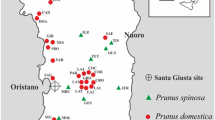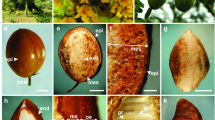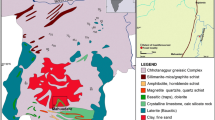Abstract
Pistacia spp. remains are common finds among archaeobotanical assemblages in prehistoric sites in Southwest Asia, both in the form of endocarps and charcoal remains. However, in the absence of a systematic study of the fruit morphology, the archaeobotanical remains of Pistacia cannot be identified to the species level and this deprives us of important information on their past geographical distribution and uses. This paper presents a comprehensive study of morphological and traditional morphometric characteristics of modern endocarps of six Pistacia species indigenous to Southwest Asia: P. atlantica Desf., P. eurycarpa Yalt., P. khinjuk Stocks, P. lentiscus L., P. terebinthus L. and P. vera L. The observation of recurring morphological features that were shown to remain stable during experimental carbonisation allowed us to set up an identification key whose efficiency was tested through a blind test. The application of established identification criteria to archaeobotanical material from the Late Aceramic Neolithic site of Khirokitia-Vounoi in Cyprus, enables an in-depth discussion on the biogeography and use of Pistacia species in prehistoric Cyprus. Finally, the paper identifies directions for future research on a major plant resource of the past.











Similar content being viewed by others
References
Ahmed HM (2017) Traditional uses of Kurdish medicinal plant Pistacia atlantica subsp. kurdica Zohary in Ranya, Southern Kurdistan. Genet Resour Crop Evol 64:1,473–1,484. https://doi.org/10.1007/s10722-017-0522-4
Al-Saghir MG (2010) Phylogenetic analysis of the genus Pistacia L. (Anacardiaceae) based on morphological data. Asian J Plant Sci 9:28–35. https://doi.org/10.3923/ajps.2010.28.35
Al-Saghir MG, Porter DM (2006) Random amplified polymorphic DNA (RAPD) study of Pistacia species (Anacardiaceae). Asian J Plant Sci 5:1,002–1,006. https://doi.org/10.3923/ajps.2006.1002.1006
Al-Saghir MG, Porter DM (2012) Taxonomic revision of the genus Pistacia L. (Anacardiaceae). Am J Plant Sci 3:12–32. https://doi.org/10.4236/ajps.2012.31002
Arabnezhad H, Bahar M, Pour AT (2011) Evaluation of genetic relationships among Iranian pistachios using microsatellite markers developed from Pistacia khinjuk Stocks. Sci Hortic 128:249–254. https://doi.org/10.1016/j.scienta.2011.01.028
Astruc L (2002) L’outillage lithique taillé de Khirokitia: analyse fonctionnelle et spatiale. CRA Monographies 25. CNRS Editions, Paris
Axiotis E, Halabalaki M, Skaltsounis LA (2018) An ethnobotanical study of medicinal plants in the Greek islands of North Aegean Region. Front Pharmacol 9:409. https://doi.org/10.3389/fphar.2018.00409
Braham M, Smiri H, Cherif R (2010) Geographic distribution and impact of Eurytoma plotnikovi Nik. (Hymenoptera: Eurytomidae) and Megastigmus pistaciae Walk. (Hymenoptera: Torymidae), insects damaging pistachio nuts in Tunisia. In: Zakynthinos G (ed) XIV GREMPA meeting on pistachios and almonds, Zaragosa: CIHEAM/FAO/AUA/TEI Kalamatas/NAGREF. Options Méditerranéennes: Série A, Séminaires Méditerranéens 94, pp 187–201
Della A, Paraskeva-Hadjichambi D, Hadjichambis AC (2006) An ethnobotanical survey of wild edible plants of Paphos and Larnaca countryside of Cyprus. J Ethnobiol Ethnomed 2:34. https://doi.org/10.1186/1746-4269-2-34
FAOStat Statistical Database (2019) Food and Agriculture Organization of the United Nations. URL, Rome. https://www.fao.org/faostat/en/#data/QC. Accessed 15 Dec 2019
Fox J, Weisberg S (2019) An {R} companion to applied regression, 3rd edn. Sage Publications, Thousand Oaks. https://socialsciences.mcmaster.ca/jfox/Books/Companion/
Ghaemmaghami L, Attar F, Ghahreman A, Rahiminejad MR (2009) Geographical, morphological and taxonomic status of Pistacia khinjuk Stocks ex Stocks in Iran. Iran J Sci Technol A 33:23–29. https://doi.org/10.22099/IJSTS.2009.2199
Golan-Goldhirsh A, Barazani O, Wang ZS, Khadka DK, Saunders JA, Kostiukovsky V, Rowland LJ (2004) Genetic relationships among Mediterranean Pistacia species evaluated by RAPD and AFLP markers. Plant Syst Evol 246:9–18. https://doi.org/10.1007/s00606-004-0132-4
Grundwag M, Werker E (1976) Comparative wood anatomy as an aid to identification of Pistacia L. species. Isr J Bot 25:152–167
Hadjichambis AC, Paraskeva-Hajdichambi D, Della A et al (2008) Wild and semi-domesticated food plant consumption in seven circum-Mediterranean areas. Int J Food Sci Nutr 59:383–414. https://doi.org/10.1080/09637480701566495
Hansen J (1989) Khirokitia plant remains: preliminary report (1980–1981, 1983). In: Le Brun A (ed) Fouilles récentes à Khirokitia: Chypre, 1983–1986. Éditions Recherche sur les Civilisations, Paris, pp 235–250
Hansen J (1994) Khirokitia plant remains: preliminary report (1986, 1988–1990). In: Le Brun A (ed) Fouilles récentes à Khirokitia: Chypre, 1988–1991. Éditions Recherche sur les Civilisations, Paris, pp 393–409
Kafkas S (2006) Phylogenetic analysis of the genus Pistacia by AFLP markers. Plant Syst Evol 262:113–124. https://doi.org/10.1007/s00606-006-0460-7
Kafkas S, Perl-Treves R (2001) Morphological and molecular phylogeny of Pistacia species in Turkey. Theor Appl Genet 102:908–915. https://doi.org/10.1007/s001220000526
Kafkas S, Perl-Treves R (2002) Interspecific relationships in Pistacia based on RAPD fingerprinting. HortScience 37:168–171. https://doi.org/10.21273/HORTSCI.37.1.168
Karimi HR, Kafkas S (2011) Genetic relationships among Pistacia species studied by SAMPL markers. Plant Syst Evol 297:207–212. https://doi.org/10.1007/s00606-011-0508-1
Karimi HR, Zamani Z, Ebadi A, Fatahi MR (2009) Morphological diversity of Pistacia species in Iran. Genet Resour Crop Evol 56:561–571. https://doi.org/10.1007/s10722-008-9386-y
Katsiotis A, Hagidimitriou M, Drossou A, Pontikis C, Loukas M (2003) Genetic relationships among species and cultivars of Pistacia using RAPDs and AFLPs. Euphytica 132:279–286. https://doi.org/10.1023/A:102502732
Kislev ME (1988) Fruit remains. In: Rothenberg B (ed) The Egyptian mining temple at Timna. Institute for Archaeo-Metallurgical Studies, London, pp 236–240
Lanfranchi F, Mai BT, Girard M (1999) La fabrication d’huile de lentisque (Listincu ou chessa) en Sardaigne. J agric tradit bot appl 41:81–100. https://doi.org/10.3406/jatba.1999.3712
Le Brun A (ed) (1984) Fouilles récentes à Khirokitia (Chypre): 1977–1981. Éditions Recherche sur les Civilisations, Paris
Le Brun A (ed) (1989) Fouilles récentes à Khirokitia (Chypre): 1983–1986. Éditions Recherche sur les Civilisations, Paris
Le Brun A (ed) (1994) Fouilles récentes à Khirokitia (Chypre): 1988–1991. Éditions Recherche sur les Civilisations, Paris
Legrand A (2007) Fabrication et utilisation de l’outillage en matières osseuses du Néolithique de Chypre: Khirokitia et Cap Andreas-Kastros. BAR international series 1978. Archeopress, Oxford
Linnaeus C (1753) Species plantarum. Salvius, Stockholm [A facsimile of the first edition 1753, 1957–1959, vol 2. The Ray Society, London]
Loi C (2013) Preliminary studies about the productive chain of lentisk oil through ethnographic witness. In: Lugli F, Stoppiello AA, Biagetti S (eds) Ethnoarchaeology: current research and field methods. Conference Proceedings, Rome, 13th–14th May 2010. BAR Internat Ser 2472, Oxford, pp 58–62
Meikle RD (1977) Flora of Cyprus, vol 1. Bentham-Moxon Trust Royal Botanic Gardens, Kew
Miller N (1984) Some plant remains from Khirokitia, Cyprus: 1977 and 1978 excavations. In: Le Brun A (ed) Fouilles récentes à Khirokitia (Chypre): 1977–1981. Éditions Recherche sur les Civilisations, Paris, pp 183–188
Mills JS, White R (1989) The identity of the resins from the Late Bronze Age shipwreck at Ulu Burun (Kaş). Archaeometry 31:37–44. https://doi.org/10.1111/j.1475-4754.1989.tb01054.x
Murray MA (2003) The plant remains. In: Peltenburg E (ed) The colonisation and settlement of Cyprus: investigations at Kissonerga-Mylouthkia, 1976–1996. Paul Åströms, Sävedalen, pp 59–71
Neumann K, Schoch W, Détienne P, Schweingruber FH (2001) Woods of the Sahara and the Sahel: an anatomical atlas. Haupt, Bern
Padulosi S, Hadj-Hassan A (eds) (2001) Towards a comprehensive documentation and use of Pistacia genetic diversity in Central and West Asia, North Africa and Europe. Report of the IPGRI Workshop, 14–17 December 1988, Irbid, Jordan. International Plant Genetic Resources Institute, Rome
Parés A (2015) Pratiques d’exploitation et d’utilisation des ressources végétales dans un village du Néolithique précéramique chypriote: l’étude carpologique de Khirokitia. Unpublished PhD Dissertation, Université Paris I Panthéon-Sorbonne, École doctorale d’archéologie (ED 112)
Parés A, Tengberg M (2017) Étude des pratiques d’exploitation et d’utilisation des ressources végétales du village de Khirokitia (Chypre) au Néolithique précéramique récent chypriote (VIIe-VIe millénaires av. J.-C.). In: Vinge JD, Briois F, Tengberg M (eds) Nouvelles données sur les débuts du Néolithique à Chypre/New data on the beginnings of the Neolithic in Cyprus. Actes de la séance de la Société préhistorique française. Société préhistorique française, Paris, pp 241–252
Parfitt DE, Badenes ML (1997) Phylogeny of the genus Pistacia as determined from analysis of the chloroplast genome. Proc Natl Acad Sci USA 94:7,987–7,992. https://doi.org/10.1073/pnas.94.15.7987
R Core Team (2018) A language and environment for statistical computing. Version 3.5.2. R Foundation for statistical computing, Vienna, Austria. https://www.R-project.org/
Rechinger KH (1969) Flora Iranica 63: Anacardiaceae. Akademische Druck- und Verlagsanstalt, Graz
Schweingruber FH (1987) Anatomy of European woods: an atlas for the identification of European trees, shrubs and dwarf shrubs. Kessel, Remagen-Oberwinter
Shanjani SP, Mardi M, Pazouki L et al (2009) Analysis of the molecular variation between and within cultivated and wild Pistacia species using AFLPs. Tree Genet Genomes 5:447–458. https://doi.org/10.1007/s11295-008-0198-1
Stern B, Heron C, Tellefsen T, Serpico M (2008) New investigations into the Uluburun resin cargo. J Archaeol Sci 35:2,188–2,203. https://doi.org/10.1016/j.jas.2008.02.004
Talebi M, Kazemi M, Sayed-Tabatabaei E (2012) Molecular diversity and phylogenetic relationships of Pistacia vera, Pistacia atlantica subsp. mutica and Pistacia khinjuk using SRAP markers. Biochem Syst Ecol 44:179–185. https://doi.org/10.1016/j.bse.2012.05.013
Thiébault S (2003) Les paysages végétaux de Chypre au Néolithique: premières données anthracologiques. In: Guilaine JJ, Le Brun A (eds) Le Néolithique de Chypre. Bulletin de Correspondance Hellénique Supplément 43. École Française d’Athènes, Athènes, pp 221–230
Tsintides TC, Hadjikyirakou GN, Christodoulou CS (2002) Trees and shrubs in Cyprus. Foundation Anastasios G. Leventis, Cyprus Forest Association, Nicosia
Wickham H, François R, Henry L, Müller K (2019) dplyr: a grammar of data manipulation. R package version 0.8.3. https://CRAN.R-project.org/package=dplyr
Willcox G (2016) Les fruits au Proche-Orient avant la domestication des fruitiers. In: Ruas M-P (ed) Des fruits d’ici et d’ailleurs: Regards sur l’histoire de quelques fruits consommés en Europe. Collection Histoire des savoirs, Omniscience, Montreuil, pp 41–54
Yaltirik F (1967) Anacardiaceae. In: Davis PH (ed) Flora of Turkey, vol 2. Edinburgh University Press, Edinburgh, pp 544–548
Yi T, Jun W, Golan-Goldhirsh A, Parfitt DE (2008) Phylogenetics and reticulate evolution in Pistacia (Anacardiaceae). Am J Bot 95:241–251. https://doi.org/10.3732/ajb.95.2.241
Zohary D (1996) The genus Pistacia L. In: Padulosi S, Caruso T, Barone E (eds) Taxonomy, distribution, conservation and uses of Pistacia genetic resources—workshop report. International Plant Genetic Resources Institute, Rome, pp 1–11
Zohary M (1952) A monographical study of the genus Pistacia. Palest J Bot Jerus Ser 5:187–228
Zohary M (1973) Geobotanical foundations of the Middle East, vol 2. Fischer, Stuttgart
Zohary M (1986) Flora palaestina. Israel Academy of Sciences and Humanities, Jerusalem
Zohary D, Hopf M (2004) Domestication of plants in the old world, 3rd edn. Oxford University Press, New York
Acknowledgements
The present paper is published within the framework of Maria Rousou’s PhD research, supported by an Onassis Foundation scholarship (ID: F ZO 066-1/2018-2019) and by the 7th Scholarship Programme of the Sylvia Ioannou Foundation; MR also would like to thank the Department Homme et Environnement (MNHN, France) for funding her Master internship. We would like to acknowledge the curators of the Muséum national d’Histoire naturelle, Paris (P), France and Royal Botanic Garden, Edinburgh (E), UK Herbarium for the permission to observe, study and sample botanic material; Porter Lowry (Institut de Systématique, Évolution, Biodiversité, UMR 7205-CNRS, MNHN) and Lesley Scott (Assistant Herbarium Curator, RBGE) for advice and facilitating the study of herbarium specimens at the MNHN Herbarium and RBGE Herbarium respectively; Myriam Gaudeul (Institut de Systématique, Évolution, Biodiversité, UMR 7205-CNRS, MNHN) and Heleen Plaisier (Assistant Herbarium Curator, RBGE) for the sampling of botanical specimens; Alain Le Brun (CNRS, Director of Khirokitia French Mission) and Odile Daune-Le Brun (CNRS, Co-director of Khirokitia French Mission) for giving access to the archaeobotanical material; George Willcox (Laboratoire Archéorient-MOM) for providing reference material collected in Tajikistan; Azadeh Mohaseb (UMR 7209-CNRS, MNHN) and Loïc Ponger (UMR 7196-CNRS, MNHN) for advice and support for the statistical analysis; Marie-Pierre Ruas (Director of the UMR 7209-CNRS, MNHN) for facilitating the study of the material and Michel Lemoine (UMR 7209-CNRS, MNHN) for technical support at the Plateau Archéobotanique of UMR 7209 and help with the carbonisation of modern endocarps; Cécile Callou (UMR 7209-CNRS, MNHN) for the use of equipment at the Imaging Station of the Zoology-Comparative Anatomy (Direction des Collections); Didier Geffard-Kuriyama and Jean-François Déjouannet (Atélier Iconographie Scientifique-UMS 2700-CNRS-MNHN) for their help, advice and equipment for the scientific drawings; Saskia Ryan (UMR 7209-CNRS, MNHN) and Rémy Auray for helping with the preparation of the blind test and useful comments. We also thank Amaia Arranz (University of Copenhagen, UMR7209-CNRS, MNHN); Vladimir Dabrowski (UMR 7209-CNRS, MNHN) and PhD candidates Sammy Ben Makhad (UMR7209-CNRS, MNHN), Lou Godefroy (Vrije Universiteit Amsterdam, UMR 7209-CNRS, MNHN) and Juliette Milon (UMR 7209-CNRS, MNHN) for participating in the blind test. We thank George and Elizabeth Willcox for their helpful comments and language revision of the manuscript. Finally, we acknowledge the anonymous reviewers for their insightful comments and suggestions.
Author information
Authors and Affiliations
Corresponding author
Additional information
Communicated by S. M. Valamoti.
Publisher's Note
Springer Nature remains neutral with regard to jurisdictional claims in published maps and institutional affiliations.
Electronic supplementary material
Below is the link to the electronic supplementary material.
Rights and permissions
About this article
Cite this article
Rousou, M., Parés, A., Douché, C. et al. Identification of archaeobotanical Pistacia L. fruit remains: implications for our knowledge on past distribution and use in prehistoric Cyprus. Veget Hist Archaeobot 30, 623–639 (2021). https://doi.org/10.1007/s00334-020-00812-z
Received:
Accepted:
Published:
Issue Date:
DOI: https://doi.org/10.1007/s00334-020-00812-z




